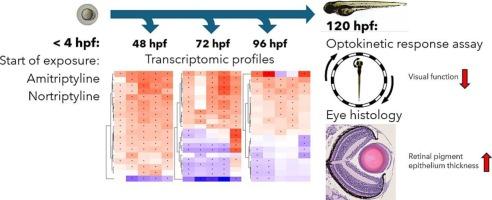阿米替林和去甲替林可引起早期斑马鱼的眼部毒性。
IF 4.3
3区 环境科学与生态学
Q2 BIOCHEMISTRY & MOLECULAR BIOLOGY
Comparative Biochemistry and Physiology C-toxicology & Pharmacology
Pub Date : 2025-09-23
DOI:10.1016/j.cbpc.2025.110363
引用次数: 0
摘要
抗抑郁药的全球使用稳步增加,由于废水处理过程中不完全去除,引起了对水生生态系统的关注。三环抗抑郁药(TCAs)通过抑制血清素和去甲肾上腺素的再摄取作用于神经系统。然而,尽管视觉功能严重依赖于神经元系统,但关于TCAs的眼毒性仍然存在知识差距。为了弥补这一知识差距,斑马鱼(Danio rerio)胚胎暴露于亚致死试验浓度的阿米替林(AMI, 0.3至300 μg/L标称,2.04至234 μg/L测量)和去甲替林(NOR, 0.03至300 μg/L标称,bb0 0.107至20.7 μg/L测量),最低试验浓度与环境有关。用光动力学反应法评估视觉功能,用组织学评估眼结构发育,并通过转录组学分析基因表达变化。在受精后120 h (hpf)仔鱼中,AMI浓度分别为4.99和234 μg/L时,其眼跳次数分别减少了26% %和86% %,而NOR浓度为20.7 μg/L时,其眼跳次数减少了65 %。组织学分析显示,AMI浓度为234 μg/L, NOR浓度为20.7 μg/L后,视网膜色素上皮厚度显著增加。转录组学分析结果显示,AMI和NOR治疗组分别有1207个和2742个差异表达基因,包括与视觉、突触信号和神经元发育有关的基因。这些发现表明,亚致死浓度的AMI和NOR会影响斑马鱼生命早期的视觉发育,这可能是一个敏感的终点,可以纳入生态风险评估。本文章由计算机程序翻译,如有差异,请以英文原文为准。

Amitriptyline and nortriptyline induce ocular toxicity in early life stage zebrafish (Danio rerio)
The global use of antidepressants has steadily increased, raising concern to aquatic ecosystems due to the incomplete removal during wastewater treatment. Tricyclic antidepressants (TCAs) act on the neuronal system by inhibiting the reuptake of serotonin and norepinephrine. However, despite visual function being heavily dependent on the neuronal system, a knowledge gap remains regarding the ocular toxicity of TCAs. To bridge this knowledge gap, zebrafish (Danio rerio) embryos were exposed to sublethal test concentrations of amitriptyline (AMI, 0.3 to 300 μg/L nominal, 2.04 to 234 μg/L measured) and nortriptyline (NOR, 0.03 to 300 μg/L nominal, >0.107 to 20.7 μg/L measured), with the lowest test concentrations being environmentally relevant. Visual function was assessed with the optokinetic response assay, eye structure development was assessed histologically, and gene expression changes were analysed via transcriptomic profiling. Larval zebrafish (120 h post fertilization (hpf)) exposed to 4.99 and 234 μg/L of AMI exhibited a 26 % and 86 % decrease in the number of eye saccades respectively, with zebrafish exposed to 20.7 μg/L of NOR exhibiting a 65 % decrease. Histological analysis indicated a significant increase of the retinal pigment epithelium thickness after exposure to 234 μg/L of AMI and 20.7 μg/L of NOR. Transcriptomic analysis resulted in 1207 and 2742 differentially expressed genes across both AMI and NOR treatment groups respectively, including genes involved in vision, synaptic signaling, and neuronal development. These findings demonstrate that sublethal concentrations of AMI and NOR affect early life stage zebrafish visual development, which may be sensitive endpoint that could be incorporated into ecological risk assessments.
求助全文
通过发布文献求助,成功后即可免费获取论文全文。
去求助
来源期刊
CiteScore
7.50
自引率
5.10%
发文量
206
审稿时长
30 days
期刊介绍:
Part C: Toxicology and Pharmacology. This journal is concerned with chemical and drug action at different levels of organization, biotransformation of xenobiotics, mechanisms of toxicity, including reactive oxygen species and carcinogenesis, endocrine disruptors, natural products chemistry, and signal transduction with a molecular approach to these fields.

 求助内容:
求助内容: 应助结果提醒方式:
应助结果提醒方式:


